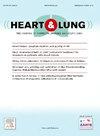Comparison of spontaneous breathing test techniques for heart failure patients: A single-center, prospective, open-label, randomized controlled study
IF 2.6
4区 医学
Q2 CARDIAC & CARDIOVASCULAR SYSTEMS
引用次数: 0
Abstract
Background
Standardized spontaneous breathing trial (SBT) techniques for patients with heart failure (HF) are lacking.
Objectives
To compare the efficacy of low-level pressure-supported ventilation (PSV) and T-piece SBT techniques in patients with HF.
Methods
This single-center, prospective, open-label, randomized controlled study enrolled mechanically ventilated adults with stage B+ HF (Nov 2022–Apr 2024). Participants were randomized to the PSV or the T-piece group for a 30-minute SBT. Immediate extubation followed successful SBT. The primary endpoint was extubation success rate.
Results
Neither SBT nor extubation success rates differed significantly between PSV and T-pece groups. The PSV group maintained stable oxygenation during the SBT (P = 0.066), while the T-piece group significantly reduced the oxygenation index (P = 0.005). No intergroup differences existed in the ICU/hospital stays, mechanical ventilation duration, or mortality outcomes. Echocardiography revealed a higher baseline left ventricular filling pressure in SBT-failure patients (median 12.07 vs. 8.11, P = 0.002) and poorer left ventricular diastolic function in extubation-failure cases at 48 h post-extubation (median 0.65 vs. 0.85, P = 0.004).
Conclusions
Low-level PSV may be preferable for weaning patients with HF.Ultrasound serves as a critical tool for assessment and outcome prediction.
心力衰竭患者自发呼吸试验技术的比较:一项单中心、前瞻性、开放标签、随机对照研究
背景:心力衰竭患者的标准化自主呼吸试验(SBT)技术缺乏。目的比较低压力支持通气(PSV)与t片SBT技术在心衰患者中的应用效果。方法本研究为单中心、前瞻性、开放标签、随机对照研究,纳入B期+ HF机械通气成人患者(2022年11月- 2024年4月)。参与者被随机分配到PSV组或T-piece组进行30分钟的SBT。SBT成功后立即拔管。主要终点为拔管成功率。结果PSV组和t - peace组的SBT和拔管成功率无显著性差异。PSV组在SBT期间氧合稳定(P = 0.066), t片组明显降低氧合指数(P = 0.005)。ICU/住院时间、机械通气时间或死亡率结果没有组间差异。超声心动图显示,在拔管后48小时,sbt衰竭患者的基线左心室充盈压较高(中位数12.07 vs. 8.11, P = 0.002),拔管失败患者的左心室舒张功能较差(中位数0.65 vs. 0.85, P = 0.004)。结论慢水平PSV可能更适合于HF患者的断奶。超声是评估和预后预测的重要工具。
本文章由计算机程序翻译,如有差异,请以英文原文为准。
求助全文
约1分钟内获得全文
求助全文
来源期刊

Heart & Lung
医学-呼吸系统
CiteScore
4.60
自引率
3.60%
发文量
184
审稿时长
35 days
期刊介绍:
Heart & Lung: The Journal of Cardiopulmonary and Acute Care, the official publication of The American Association of Heart Failure Nurses, presents original, peer-reviewed articles on techniques, advances, investigations, and observations related to the care of patients with acute and critical illness and patients with chronic cardiac or pulmonary disorders.
The Journal''s acute care articles focus on the care of hospitalized patients, including those in the critical and acute care settings. Because most patients who are hospitalized in acute and critical care settings have chronic conditions, we are also interested in the chronically critically ill, the care of patients with chronic cardiopulmonary disorders, their rehabilitation, and disease prevention. The Journal''s heart failure articles focus on all aspects of the care of patients with this condition. Manuscripts that are relevant to populations across the human lifespan are welcome.
 求助内容:
求助内容: 应助结果提醒方式:
应助结果提醒方式:


